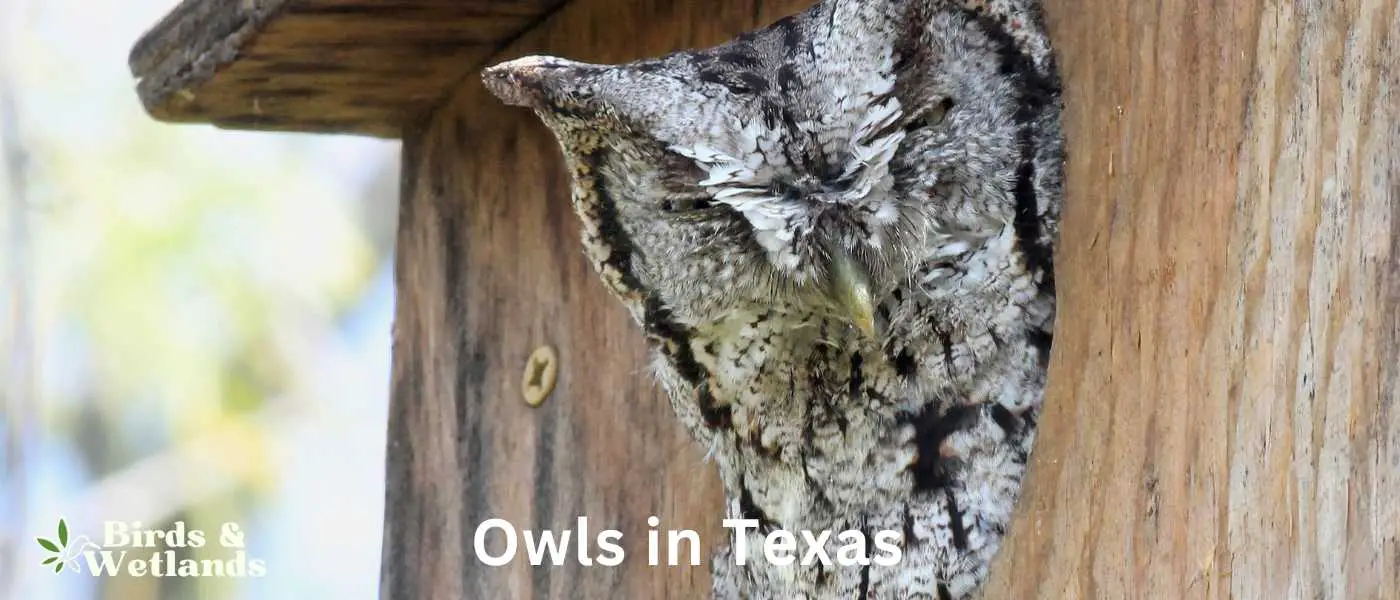Across Texas’ vast and varied landscapes, from its desert and chaparral areas to its coastal wetlands, piney woods, and sprawling prairies, a remarkable spectrum of owls thrives. The owl species present in Texas vary from the small Elf Owls of the desert to the grandeur of the Great Horned Owls, each showcasing unique behaviors and adaptations in line with their specific environments.
Texas’ Owls
| Owl Species | Frequency in Texas | Specific Locations in Texas |
|---|---|---|
| Great Horned Owl | High | Palo Duro Canyon State Park, Canyon; Brazos Bend State Park, Needville |
| Eastern Screech Owl | High | Houston Arboretum & Nature Center, Houston; Guadalupe River State Park, Spring Branch |
| Barred Owl | Moderate | Caddo Lake State Park, Karnack; Big Thicket National Preserve, Kountze |
| Long-eared Owl | Low | Caprock Canyons State Park, Quitaque; Guadalupe Mountains National Park, Salt Flat |
| Short-eared Owl | Low | Attwater Prairie Chicken National Wildlife Refuge, Eagle Lake; Anahuac National Wildlife Refuge, Anahuac |
| Northern Saw-whet Owl | Very Low | Guadalupe Mountains National Park, Salt Flat; Davis Mountains State Park, Fort Davis |
| Snowy Owl | Extremely Rare | Padre Island National Seashore, Corpus Christi (very rare sighting) |
| Barn Owl | Moderate | Brazoria National Wildlife Refuge, Angleton; Lower Rio Grande Valley National Wildlife Refuge, Alamo |
| Ferruginous Pygmy-Owl | Uncommon | Lower Rio Grande Valley |
| Western Screech Owl | Common | West Texas, especially around El Paso |
| Spotted Owl | Very Rare | Pine forests in East Texas |
| Elf Owl | Common | Desert areas, Big Bend National Park |
| Flammulated Owl | Rare | Davis Mountains |
Owl Species Found in Texas
Great Horned Owl (Bubo virginianus)


Great Horned Owl Sound
Scientific Name:Bubo virginianus
Length: 18.1-24.8 in
Wingspan: 39.8-57.1 in
Weight: 32.1-88.2 oz
The Great Horned Owl is a large owl with long wings and a large head. It’s one of the most common owls in North America.
Great Horned Owls are large, stocky birds with soft feathers that are gray to brown on their backs and white on their chests. Their faces are characterized by two black “ear” tufts, which can be raised or flattened depending on the owl’s mood. The eyes are yellow, orange, or red in color.
The habitat of the Great Horned Owl is a variety of different environments such as forests and deserts. They also live near water sources such as lakes, streams and rivers where they can hunt for fish.
The diet of the Great Horned Owl consists primarily of small mammals such as mice and rats; however they will also eat other rodents such as squirrels, rabbits and porcupines. They have been known to eat skunks too.
Eastern Screech-Owl (Megascops asio)
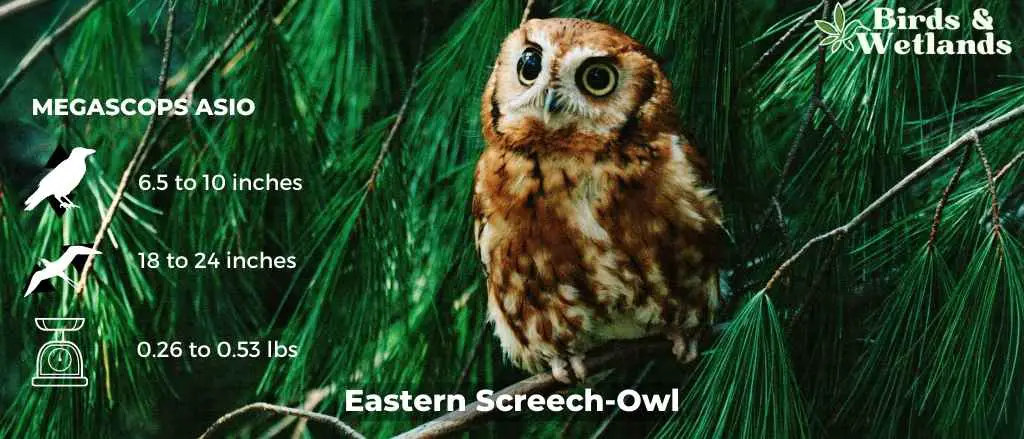
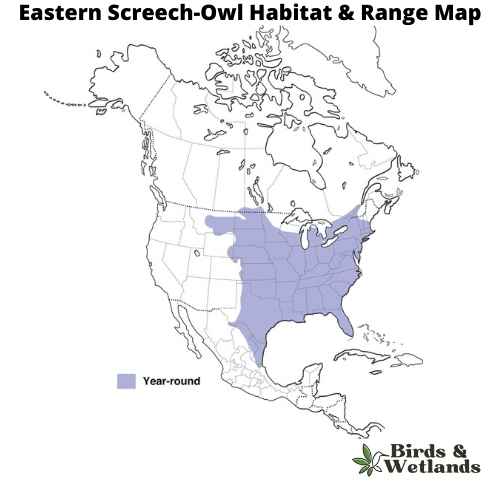
Eastern Screech-Owl Sound
Scientific Name: Megascops asio
Length: 6 to 10 in
Wingspan: 8 to 24 in
Weight: 4 – 8.5 oz
The Eastern Screech-Owl is a small owl species native to most wooded environments of the eastern half of North America, from the Canadian provinces to Florida and Texas.
Eastern Screech-Owls are relatively small and exhibit a complex pattern of gray or reddish-brown coloration, which provides excellent camouflage against tree bark.
These owls are known for their distinctive call, which is often described as a haunting trill or a whinny-like sound. Despite their name, they do not actually produce a “screech.”
Eastern Screech-Owls feed on a variety of prey, ranging from small mammals and birds to insects and even earthworms. It is primarily nocturnal, hunting at night from a low perch and swooping down onto prey.
Eastern Screech-Owls nest in tree cavities or abandoned woodpecker nests, but they readily adapt to nesting boxes where natural cavities are not available. They typically lay between 2 to 6 eggs, which are incubated primarily by the female.
Western Screech-Owl (Western Screech-Owl)
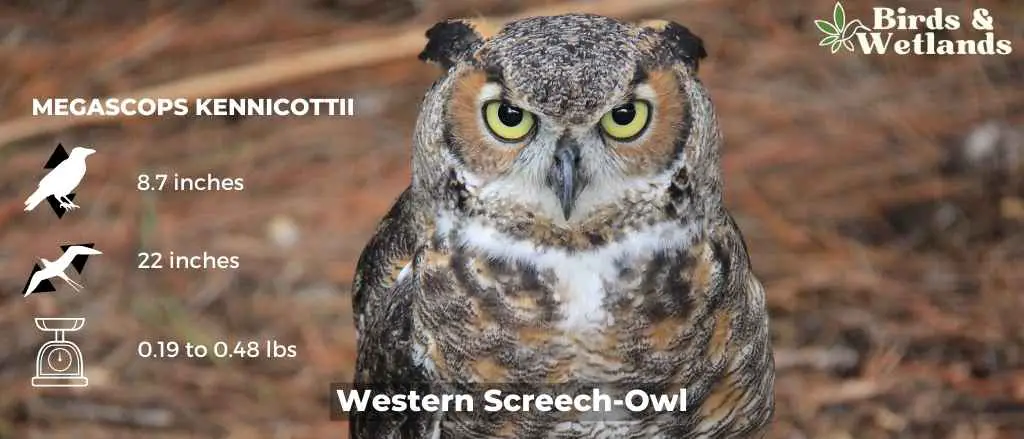
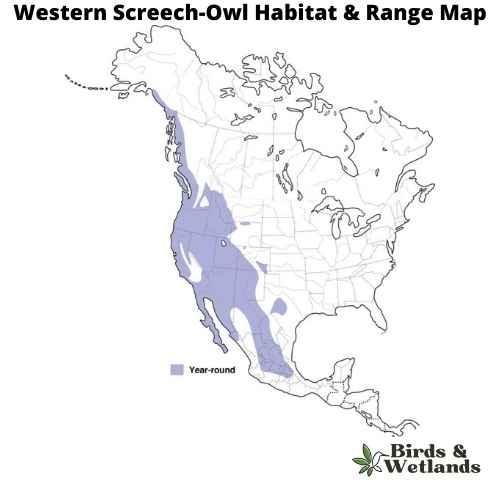
Western Screech-Owl Sound
Scientific Name: Megascops kennicottii
Length: 22 cm (8.7 in)
Wingspan: 55 cm (22 in)n
Weight: 88 to 220 g (3.1 to 7.8 oz)
The Western Screech-Owl, or Megascops kennicottii, is a small species of owl native to North and Central America. Western Screech-Owls are nocturnal predators, and its diet primarily consists of small mammals, birds, insects, and occasionally fish.
This owl is medium-sized compared to other screech-owls. It has a compact, stocky body, and is often recognized by its large head with yellow eyes surrounded by greyish-brown facial disks. The plumage is generally a mixture of grey and brown, with intricate patterns of spots and streaks that provide excellent camouflage against tree bark.
These owls prefer mixed woodland habitats, including deciduous forests and semi-open areas with trees. They often nest in tree cavities, but will also readily take to nest boxes if available. These birds are primarily non-migratory, and once they’ve established a territory, they tend to stay within the same area year-round.
Barred Owl (Strix varia)

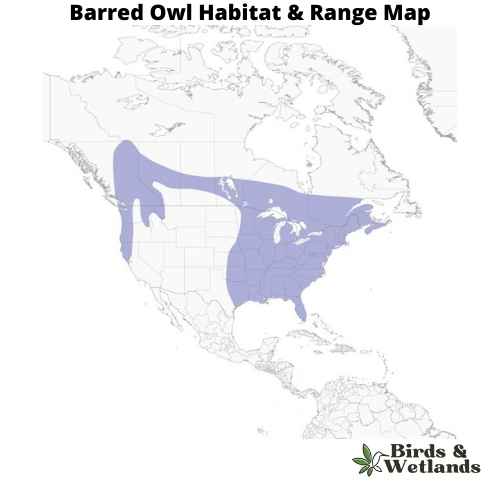
Barred Owl Sound
Scientific Name: Strix varia
Length: 40 to 63 cm (16 to 25 in)
Wingspan: 96 to 125 cm (38 to 49 in)
Weight: 468 to 1,150 g
The Barred Owl is a medium-sized owl with a barred pattern on its chest and belly. They have large yellow eyes that allow them to see well in low light conditions. Their ears are not very large which means they do not hear very well but they have excellent hearing abilities which allow them to detect sounds up to 1 mile away. Their feathers are brown and streaked with white, and they have black bars on their chests and wings.
Their habitats include forests, woodlands, orchards, parks, farmland and suburban backyards.
Barred Owls (also known as hoot owl) eat small mammals such as mice, rats and squirrels. They also eat insects such as beetles or grasshoppers. These owls hunt during the day when it is light out so that they can see their prey better than at night when they would be using senses other than sight like sound or smell to find their food source.
Barred owls are monogamous birds which means they mate for life. They build nests in trees or cavities on the ground and lay 2-4 eggs per year. The incubation period for these eggs lasts about 28 days before hatching takes place.
Barn Owl (Tyto alba)

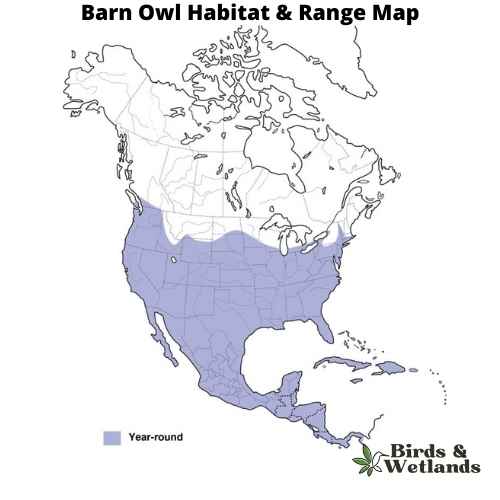
Barn Owl Sound
Scientific Name: Tyto alba
Length: 13 to 15 in
Wingspan: 31 to 37 in
Weight: 9.2 oz
The Barn Owl is a widespread species of owl known for its distinctive heart-shaped facial disc.
Barn Owls are medium-sized owls, they are pale overall with golden-brown wings and back, contrasted by a white face, chest, and belly. Their most notable feature is their heart-shaped facial disc, which helps channel sound to their ears.
Barn Owls are typically found in open habitats, including farmland, woodland, and marshes. They are named for their habit of nesting in human structures such as barns, church towers, and in the hollows of large trees. These owls are nocturnal, hunting at night and roosting during the day.
The diet of Barn Owls primarily consists of small mammals, particularly rodents such as mice and rats. They are known for their silent flight, which allows them to sneak up on their prey without detection.
Barn Owls have a unique nesting behavior. They do not build nests, but instead, lay their eggs directly on the bare surface of a secluded ledge or cavity. A female typically lays 4-7 eggs, and both parents help incubate the eggs and care for the chicks.
The long-eared owl (Asio otus)
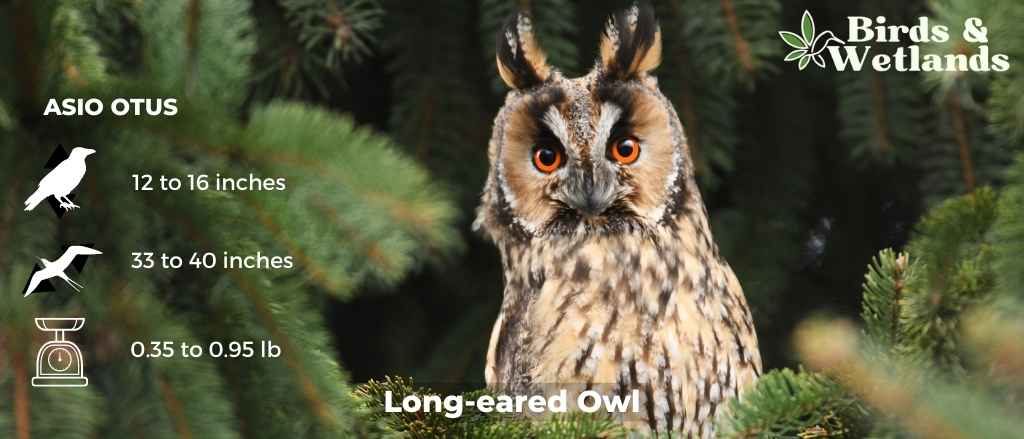
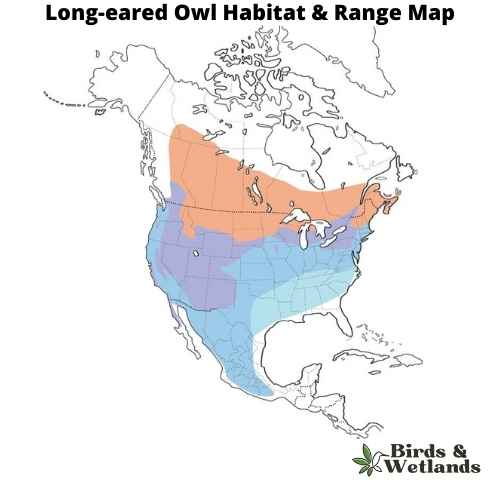
Long-eared Owl Sound
Scientific Name: Asio otus
Length: 12 and 16 in
Wingspan: 2 ft 10 in to 3 ft 4 in
Weight: 5.6 to 15.3 oz
The Long-eared Owl is a medium-sized owl species known for its distinctively long ear tufts, which can be raised or lowered depending on the bird’s mood or intention.
Long-eared Owls have mottled brown and cream plumage, which provides excellent camouflage among the trees. Their most distinctive features are their long, black-tipped ear tufts, which are set closer to the center of the head than in most other owl species.
These owls inhabit a wide variety of habitats, including deciduous and coniferous forests, woodlands, and even semi-deserts.
The Long-eared Owl’s diet primarily consists of small mammals, especially voles, but they will also take small birds and insects. They are skillful hunters, often capturing prey from a perch or in flight.
In terms of nesting behavior, Long-eared Owls do not construct their own nests, instead they take over old nests built by other bird species, usually those of corvids or other large birds. They lay an average of 4 to 5 eggs, which are incubated by the female while the male provides food.
Short-eared Owl (Asio flammeus)
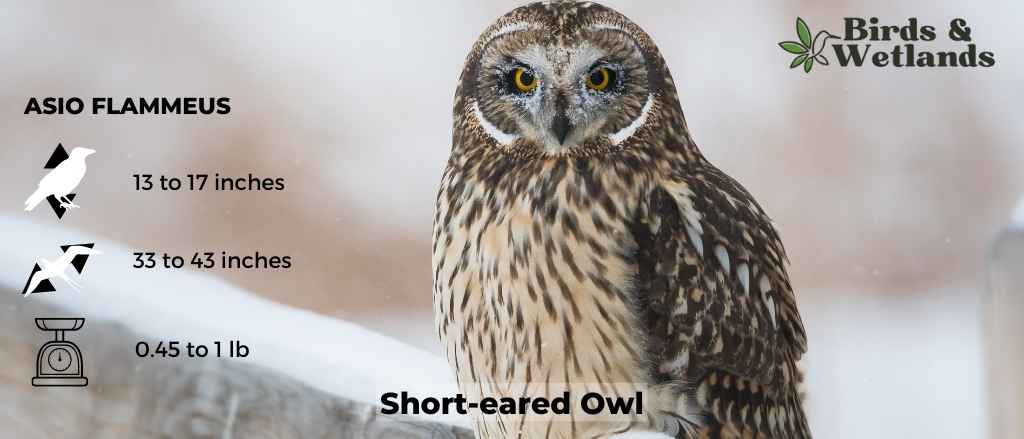
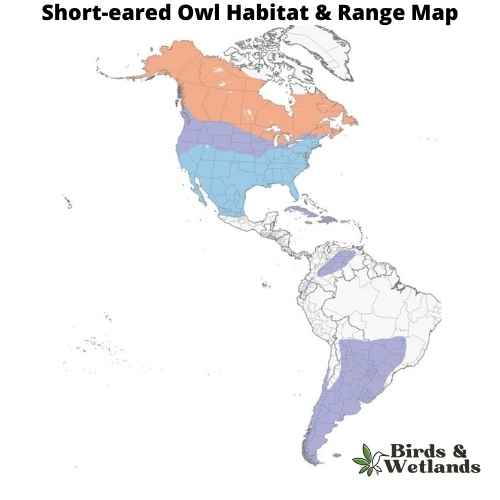
Short-eared Owl Sound
Scientific Name: Asio flammeus
Length: 13–17 in
Wingspan: 33 to 43 in
Weight: 7.3–16.8 oz
The Short-eared Owl is a medium-sized owl species with a wide distribution, found across North and South America, Europe, Asia, and many Pacific islands. Despite its name, the “ears” of the Short-eared Owl are not often visible, as they are small and tend to blend with the bird’s feathers.
The owls are predominantly brown with buff and white accents throughout their body and wings, and dark patches around their yellow eyes.
Short-eared Owls diet consists largely of small mammals, especially voles. However, they are opportunistic hunters and will also prey on a variety of other animals, including other birds, when available.
Their habitat is characterized by open areas like grasslands, marshes, and tundra. They nest on the ground, which is unusual for owls, and this makes them vulnerable to ground predators. As such, they often live in areas with tall grasses or other ground cover for protection.
Northern Saw-whet Owl (Aegolius acadicus)
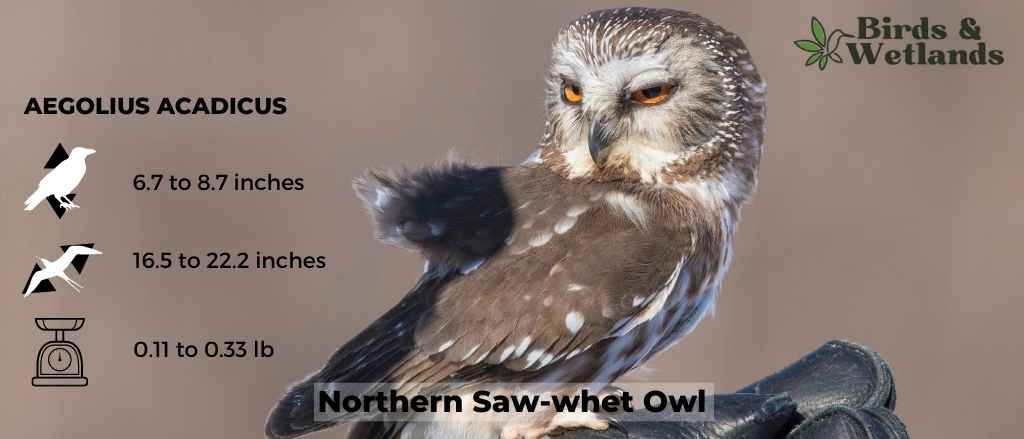
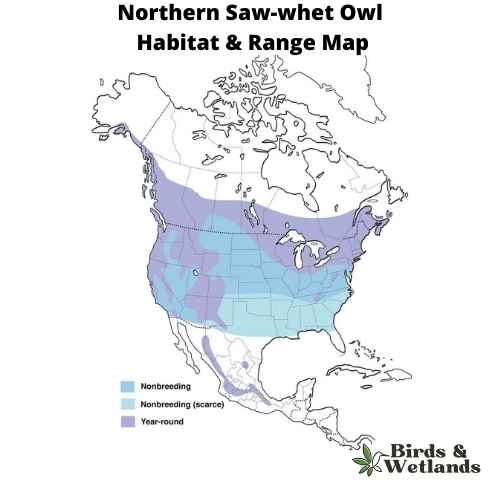
Northern Saw-whet Owl Sound
Scientific Name: Aegolius acadicus
Length: 17–22 cm (6.7–8.7 in)
Wingspan: 42–56.3 cm (16.5–22.2 in)
Weight: 54 to 151 g (1.9 to 5.3 oz)
The Northern Saw-whet Owl is a tiny, speckled gray owl and it’s one of the smallest owls in North America. It’s also known as the Little Owl or Wood Owl in some areas.
Northern Saw-whet Owls have dark brown eyes, white eyebrows, and yellow beak. It has brownish-grey feathers that are spotted with white. The owl’s legs are covered in feathers and appear nearly invisible when the bird is perched on a branch or tree.
In the winter they migrate south to warmer climates. They prefer to live in dense coniferous forest with large trees but will occasionally nest in shrubs or other vegetation that can protect them from predators.
The Northern Saw-whet Owl eats mice and voles (small rodents), small birds, frogs, salamanders, moles and shrews, but unlike most owls they chop their prey up and spread over a few meals. They will also eat insects like beetles and grasshoppers if they are available. It hunts from a perch at night using its excellent hearing to locate prey items within about 30 feet (9 meters) of its nest.
These owls nest in tree cavities usually located close to water sources such as lakes or rivers where they can find their food source (insects). They lay 2-4 eggs at one time which incubate for about 30 days before hatching.
Snowy owl (Bubo scandiacus)
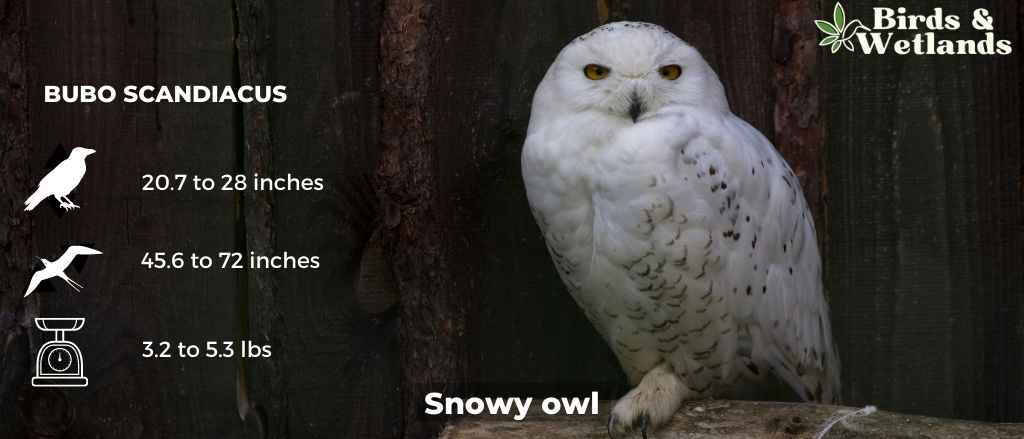
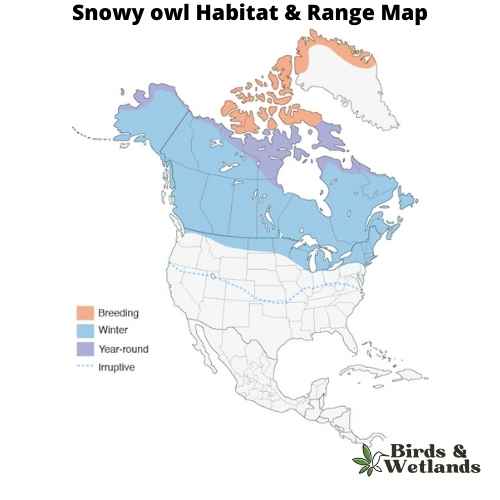
Snowy owl Sound
Scientific Name: Bubo scandiacus
Length: 20.7 to 28 in
Wingspan: 3 ft 10 in to 6 ft 0 in
Weight: 3.2lb to 5.3lb
The Snowy Owl, is of the most well-known species of owls, the Snowy Owl is renowned for its striking appearance and adaptations to its extreme environment.
Snowy Owls are medium sized birds that possess a rounded head, yellow eyes, and a black beak. The most distinctive feature of the Snowy Owl is its white plumage, which provides effective camouflage in its snowy habitat. Male Snowy Owls are often almost completely white, while females and younger owls have more extensive dark barring on their plumage.
Unlike many owl species, Snowy Owls are primarily diurnal, which means they are active during the day. This is an adaptation to life in the Arctic, where there can be 24 hours of daylight in the summer. Their diet mainly consists of small mammals, particularly lemmings, but they are known to eat a variety of animals including birds, fish, and even carrion when necessary.
Snowy Owls nest on the ground, usually on a mound or boulder. Their breeding success is closely tied to the availability of food, and in good years a single pair of owls can raise a large brood of chicks.
Burrowing Owl (Athene cunicularia)
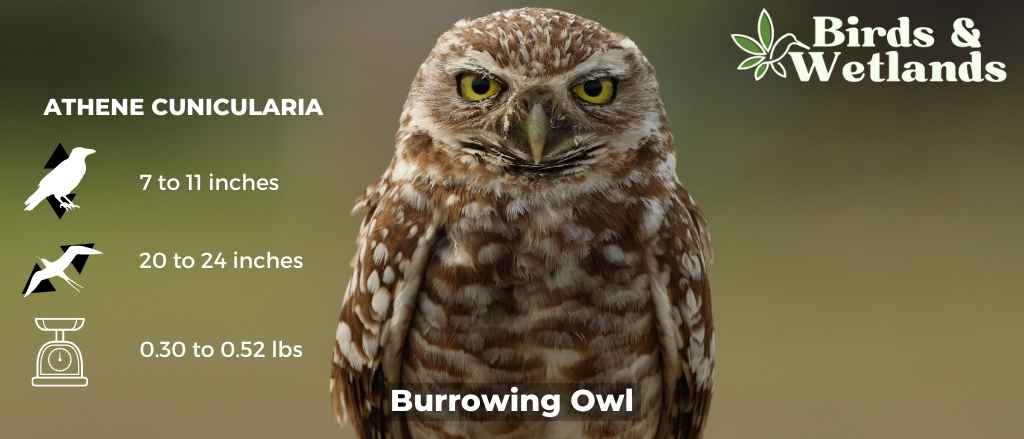
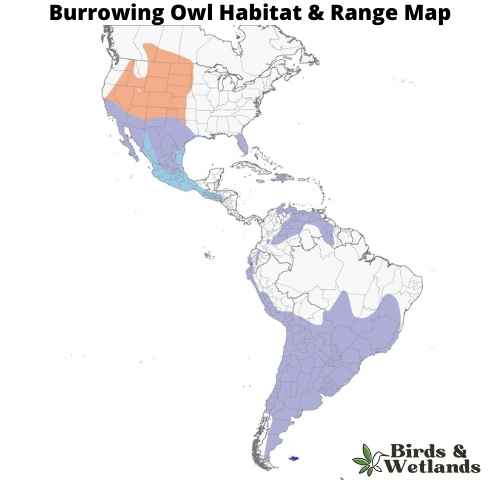
Burrowing Owl Sound
Scientific Name: Athene cunicularia
Length: 7–11 in
Wingspan: 20–24 in
Weight:5–8 oz
The Burrowing Owl is a small, long-legged species of owl found in North and South America. Known for its unusual habit of living in burrows in the ground.
Burrowing Owls have a rounded head with no ear tufts and bright yellow eyes. Their overall coloration is mottled brown and white with a distinct white “eyebrow” above each eye.
Their primary habitat includes open landscapes such as grasslands, deserts, agricultural areas, golf courses, and even airports. As their name suggests, these owls often reside in burrows, many of which are abandoned by prairie dogs, ground squirrels, or other burrowing animals. In some cases, they may also dig their own burrows.
Burrowing Owls diet consists mainly of small mammals and insects, but they also eat birds and reptiles.
Burrowing Owls have a unique nesting behavior. They lay their eggs in an underground burrow to protect them from predators and extreme weather. Clutch sizes range from 6 to 11 eggs, which are incubated for about a month before hatching.
Great Gray Owl (Strix nebulosa)


Great Gray Owl Sound
Scientific Name: Strix nebulosa
Length: 26 in to 28 in
Wingspan: 56 to 60 in
Weight:2.2 lb to 2.85lb
The Great Gray Owl, or Strix nebulosa, is a very large owl, native to the boreal forests across North America and Eurasia. Despite its great size, it’s more so known for its impressive appearance rather than its weight, as it is outweighed by several other large owl species.
The Great Gray Owl has a large, rounded head with a grey face and yellow eyes, surrounded by concentric circles of dark and light feathering. It is known for its bow-tie-shaped white moustache stripe and black chin spot.
One of the distinguishing characteristics of this owl is its elongated tail, which makes it appear much larger than it actually is. The plumage is mostly grey with a unique pattern of fine white, gray, and brown streaks and bars. Despite its large size, its diet primarily consists of small rodents, like voles and pocket gophers.
Great Gray Owls prefer dense coniferous forests, often near open meadows or bogs. Rather than building their own nests, they typically use nests previously built by other large birds, such as hawks or crows. They also occasionally nest in broken-top trees or on man-made structures.
Elf Owl
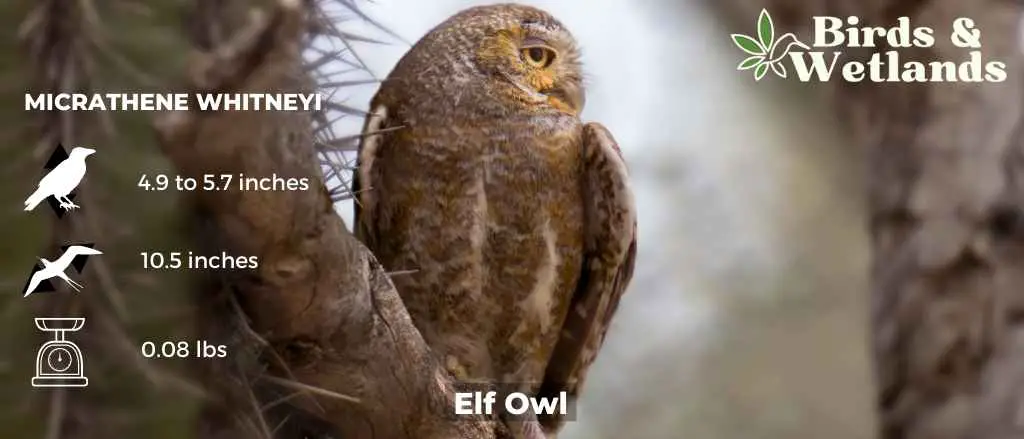
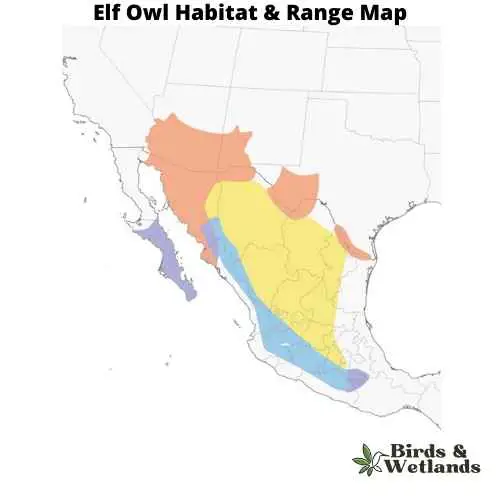
Elf Owl Sound
Scientific Name: Micrathene whitneyi
Length: 4.9 to 5.7 in
Wingspan: 10.5 in
Weight: 1.4 oz
The Elf Owl is a small species of owl that inhabits the southwestern regions of the United States and Mexico. It holds the distinction of being one of the smallest owl species in the world.
Elf Owls are tiny, they have a round head with no ear tufts, large yellow eyes, and a pale gray-brown body with a lightly spotted or streaked pattern.
The primary habitat for Elf Owls includes desert and woodland areas. They are especially fond of regions with saguaro cacti or other types of cavities in trees, which they use for nesting. They are nocturnal creatures, with most of their activity occurring after dusk.
Elf Owls feed primarily on a diet of insects and other small invertebrates. Occasionally, they may also eat small mammals and birds. They are known for their agile flight and keen hunting skills, often catching insects in midair.
When it comes to nesting, Elf Owls take advantage of the natural cavities in trees or cacti, where they lay a clutch of 2 to 4 eggs. The female is responsible for incubation, which lasts about three weeks, while the male provides food.
The Spotted Owl (Strix occidentalis)
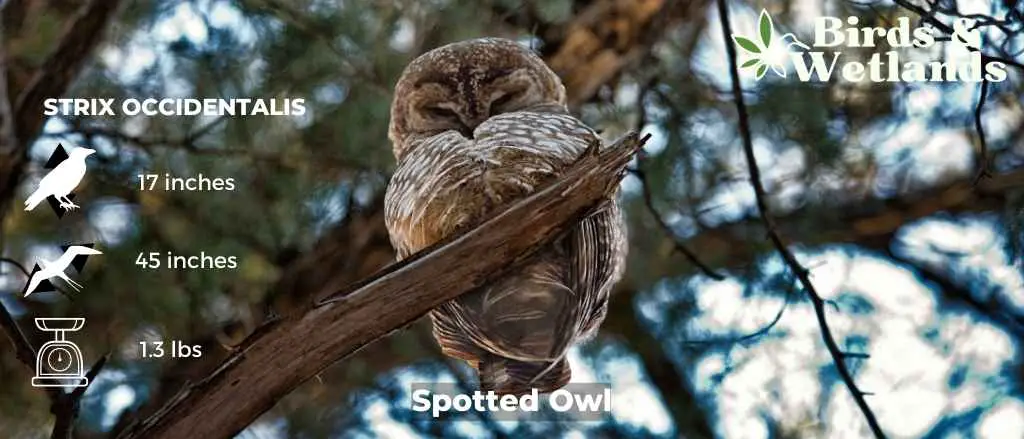
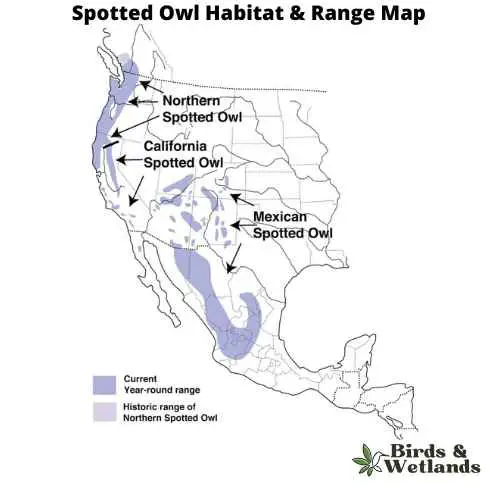
Scientific Name: Strix occidentalis
Length: 17in
Wingspan: 45 in
Weight: 1.3 lb
Spotted owls have a large head and eyes, with a small beak. Their feathers are light brown in color, with white spots on their wing feathers, and dark bars on their tail feathers. They have white spots on their upper body and wings. It has large yellow eyes and a yellow beak.
Its habitat is usually dense coniferous forests. It can be found in old-growth forests of the Pacific Northwest, where it often nests in trees at least 40 feet high.
The spotted owl feeds on small mammals such as rodents and squirrels as well as birds like quail and grouse. It hunts at night when most other animals are sleeping so that it doesn’t get caught by predators like hawks or snakes which also hunt at night time.
Spotted Owls usually nest in tree cavities created by woodpeckers or other birds who eat holes in trees where they make their nests too! The female lays three eggs at a time and both parents take turns sitting on them while they’re incubating (hatching). Once they hatch out, the parents take turns feeding them until they are old enough to hunt for themselves.
Where to Spot Texas’ Owls
Big Bend National Park, Brewster County: The park’s vast wilderness provides excellent habitats for various owl species. You may encounter the Elf Owl, Western Screech-Owl, and the rare Flammulated Owl.
Laguna Atascosa National Wildlife Refuge, Cameron County: Located near the southern tip of Texas, the refuge is home to several owls such as the Eastern Screech-Owl and Great Horned Owl.
Guadalupe Mountains National Park, Salt Flat: The mixed woodland and desert landscapes of the park are home to several owl species, including the Western Screech-Owl, Great Horned Owl, and Northern Pygmy Owl.
Bentsen-Rio Grande Valley State Park, Mission: Known as a birdwatcher’s paradise, you can spot the rare Ferruginous Pygmy Owl and Eastern Screech-Owl here.
Cibolo Nature Center, Boerne: A short drive from San Antonio, this nature center is a great place to spot Eastern Screech-Owls and Barred Owls.
| State | Main Owl Watching Sites |
|---|---|
| New Mexico Owls | Gila National Forest, Bosque del Apache National Wildlife Refuge |
| Oklahoma Owls | Wichita Mountains Wildlife Refuge, Ouachita National Forest |
| Arkansas Owls | Ozark National Forest, Arkansas Post National Memorial |
| Louisiana Owls | Atchafalaya National Wildlife Refuge, Kisatchie National Forest |
Tips on How to Spot Owls in Texas
Locations: Big Bend National Park is known for its diverse bird population and is a great spot for viewing Elf Owls. Guadalupe Mountains National Park, and the Rio Grande Valley – particularly the Santa Ana National Wildlife Refuge, are also excellent places for owl spotting.
Time: Owls are predominantly nocturnal creatures, so the best times to spot them are in the early morning or late evening. In certain seasons, you may also spot them during the day.
Calls and Sounds: Understanding owl calls is an essential part of spotting them. Each species has distinct vocalizations. There are many online resources to familiarize yourself with these calls.
Nests and Roosting Spots: Look for nests in tree cavities, on the ground for burrowing owls, or in old buildings for barn owls. During the day, you might spot owls resting in their roosts.
Equipment: A good pair of binoculars is necessary. If you plan to go spotting at night, consider a red flashlight to help you see without disturbing the wildlife.
Guided Tours and Birding Groups: Consider joining a local bird watching group or taking a guided tour. Experienced birders can provide valuable knowledge and help you spot these elusive creatures.
Patience and Observation: Finding owls requires patience and careful observation. Look for movements, listen for sounds, and pay attention to signs like owl pellets at the base of trees.
Remember, it’s important to respect these beautiful creatures and their habitats. Do not disturb nests or roosting birds, and observe from a respectful distance. The use of recorded owl calls to attract them is generally frowned upon in the birding community and can be harmful to the owls, so it’s better to rely on your own observations and patience.

